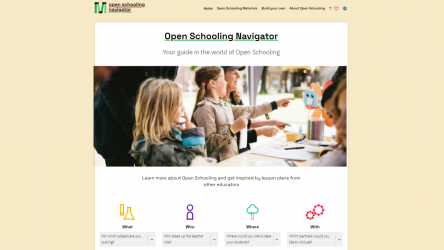Finding new ways to experiment, innovate and “open up” education has been a key agenda point across the European Union for some time now. However, making this change can be challenging for educational institutions and, most importantly, for the teachers themselves. Teachers are willing to innovate, but are faced with considerable time and resource constraints to adopt and trial new things. To reduce the noise often seen around following new educational practices, the EU project Make it Open, has been working with teachers to create an online platform - The Open Schooling Navigator - which contains all the resources needed to help schools transition into a more open school.
We dived a little deeper into the idea behind this platform, by speaking with WAAG, who led on the creation of this platform and who gave us some further insights into its design and unique functionalities, in particular the ways in which the platform is adaptable, accessible, and functionable. As they said, for 8 years WAAG has been putting “maker education on the map in the Netherlands''. From there, they are “taking things a step further” by contributing to the Make it Open project, and leading on the creation of the Make it Open Navigator, a tool made by teachers, for teachers.
Adaptability
This online interactive platform has been produced to reduce the barrier for entry into open schooling by making it simple and adaptable for teachers new and experienced with the concept. It provides tested and approved learning materials that encourage students to solve challenges present in their community. What sets this platform apart from other frameworks is that a strong driving force of its creation is the amount of voices incorporated into its design. As WAAG mentioned, the platform was co-created with all partners involved in the project, as well as teachers from The Netherlands, The United Kingdom, Poland, Israel, France and Belgium on the ground, who all co-developed and tested the tools present on the navigator. They also provided inputs on how the navigator should look like and what features it should offer to teachers. This extensive reach in location and culture allowed the project to develop tools that are useful for schools in many different realities, cultures, and learning ecosystems as opposed to being a burden for them.
Accessibility
Making sure accessibility was at the forefront of the design process was key for the team at WAAG. As Pam said:
“Teachers are always way too busy, and what we had in the back of our minds when we made the navigator, is that it should be super-fast and smart to use and inspire new people and people that are maybe a little bit afraid to try something new.”
To achieve this, the tools that shape the Navigator will be released in 11 languages in unique fonts, sizes and colours to make the navigator as inclusive as possible. There will even be an option to switch the website into Braille for the visually impaired. This drive for accessibility did not come without its challenges though. Accommodating for multiple languages with different formatting and alphabet posed its challenges but as WAAG said:
“For us, being inclusive is one of WAAGs values, so our aim with this platform was to make it as accessible as possible”
Functionality
A strong focus for the navigator is to ensure the user finds the resources necessary for them to run an open schooling project easily and efficiently. On the platform, teachers will be able to tailor their experience and needs through the many filters offered to make the life of a teacher or an educator easier. From filters about the subject they are looking for, the age group they wish to focus on, the stakeholders they wish to select to be a part of their open schooling journey, even up to the location where a teacher wants to take their students to. As WAAG said: “they actually have what they need to get started with open schooling projects in just a few clicks”.
A large desire amongst the early testers of this platform was they shared a need to be able to further adapt the tools given whilst also offering a personal experience. Embedded into the platform is a way for teachers to build their very own learning scenario using the predefined learning scenarios already present on the platform. From here teachers will be able to save this new Learning Scenario and favourite it to come back to later when they are ready.
Want to be involved in Make it Open?
The navigator is available now in 6 languages for you to explore. For the remaining 5 languages, they will be coming soon. However, the final piece of the Make it open house is complete. Our next step is for the 10 Make it Open Hubs present in Greece, Hungary, Israel, The Netherlands, Poland, Portugal, Romania, Spain, Sweden and the UK to introduce you to the Make it Open tools via the open schooling navigator.
If you are present in one of these countries and want to be a part of this open schooling movement, leave us your contact details and we will contact you once we kick off this next phase. Or you can simply share this article with your own network. If you are not you can still explore our platform and the tools present there and use them as you wish.
For further information visit the Make it Open website or get in contact with Ecsite – The European Network of Science Centres and Museums.

